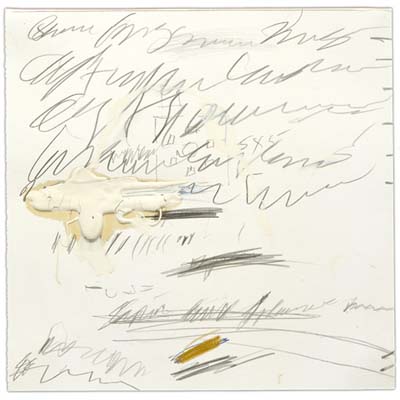 "Letter of Resignation" (detail), 1959-67 industrial paint, colored pencil, and graphite on paper 38 parts: 10 x 10 in (25.5 x 25.5 cm) each Cy Twombly Letter of Resignation "Letter of Resignation" consists of 38 individual drawings, which Cy Twombly created between the years 1959 and 1967 in Rome. While all of the drawings begin with Twombly's signature pencil line, many of the works are layered with heavily encrusted house paint and crayon. Although Twombly has enjoyed critical acclaim in recent years, at the time these drawings were made, both his practice and his formal and thematic preoccupations stood in stark contrast to the dominating pop iconography and the certainties of Minimalist form. In the work of the 1950s and 60s, Twombly vehemently sustained painterly abstraction, while embracing such high Western cultural contributions as the written word, counting systems, geometry and ideographic signs. The dialogue played out on these 38 sheets, is one wrought with obsessiveness, an obsession with dreams, history, poetry and the seductive temptation of writing. Each drawing contains one particular line of this internal dialogue and in Twombly's desire to create a new form of expression, systems are built and simultaneously destroyed. Twombly's aggressive lines, where symbols emerge and then are violently scratched out discloses his early fascination with immediacy of "primitive" art forms. The system played out over 38 sheets is ritualistic, almost fetishistic, where lines, mimicking words are laid down and then erased, subverting any attempt at deciphering. The artist does not allow the meaning of these markings to extend into the real world. In several of the sheets, Twombly fills the page with looping, energetic cursive "writing". This is similar to the "writing" found on the gray chalk-board like paintings of 1968-69 which stemmed from, Twombly's blind drawing exercises at night in 1953. In other sheets, numbers punctuate lists of markings, which are then obliterated by heavily applied impasto. Scrawling gestural passages are violently crossed out with dark pencil and thick paint is scored with chaotic scratchings. As the title of the work indicates this is a "letter", which as Heiner Bastian points out, implies a confession. The works are not numbered, but Twombly did designate a chronology while assisting Bastian on a catalogue produced in 1991. Bastian deems this body of work a farewell, calling it a "dialogue at the end of a process, which began in 1963 in a significant cycle of paintings: Dialogue of Commodus." Ausstellungsdauer: 8.11.2002 - 4.1.2003 Öffnungszeiten: Di-Sa 10 - 18 Uhr Zwirner & Wirth 32 East 69th St (between 5th and Madison Avenues) USA-New York, NY 10021 Telefon +1 212 517 86 77 Fax +1 212 517 89 59 www.zwirnerandwirth.com |